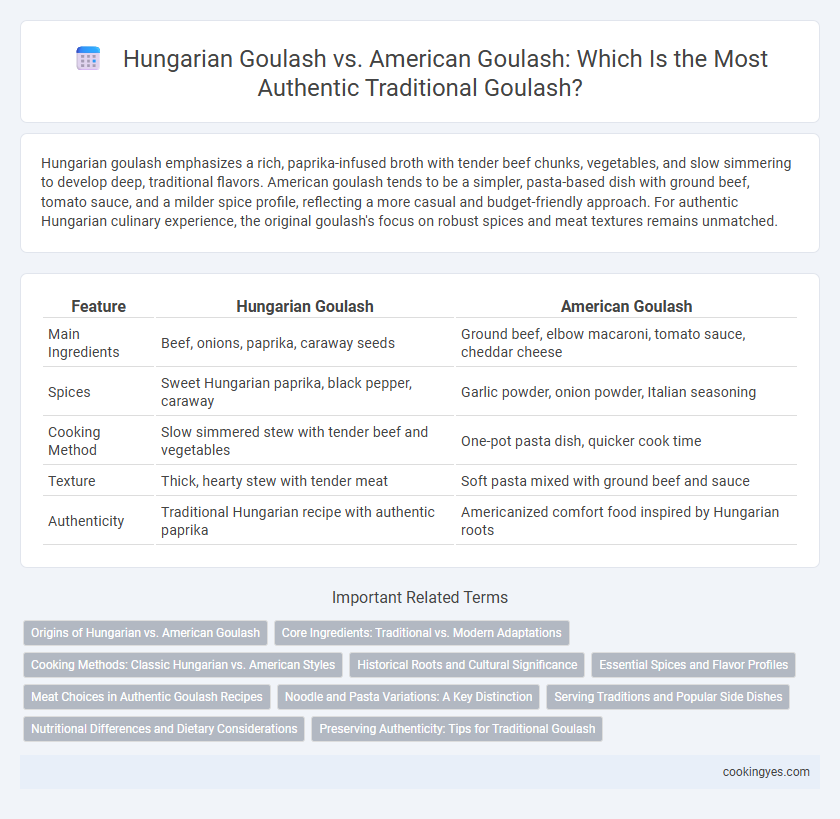Hungarian goulash emphasizes a rich, paprika-infused broth with tender beef chunks, vegetables, and slow simmering to develop deep, traditional flavors. American goulash tends to be a simpler, pasta-based dish with ground beef, tomato sauce, and a milder spice profile, reflecting a more casual and budget-friendly approach. For authentic Hungarian culinary experience, the original goulash's focus on robust spices and meat textures remains unmatched.
Table of Comparison
| Feature | Hungarian Goulash | American Goulash |
|---|---|---|
| Main Ingredients | Beef, onions, paprika, caraway seeds | Ground beef, elbow macaroni, tomato sauce, cheddar cheese |
| Spices | Sweet Hungarian paprika, black pepper, caraway | Garlic powder, onion powder, Italian seasoning |
| Cooking Method | Slow simmered stew with tender beef and vegetables | One-pot pasta dish, quicker cook time |
| Texture | Thick, hearty stew with tender meat | Soft pasta mixed with ground beef and sauce |
| Authenticity | Traditional Hungarian recipe with authentic paprika | Americanized comfort food inspired by Hungarian roots |
Origins of Hungarian vs. American Goulash
Hungarian goulash originates from a centuries-old shepherd's stew known as "gulyas," characterized by its use of paprika, beef, potatoes, and caraway seeds, deeply rooted in Hungary's pastoral traditions. American goulash, often a pasta-based dish with ground beef, tomatoes, and cheese, emerged as a convenient comfort food in the United States, evolving separately from the Hungarian original. The key distinction between Hungarian and American goulash lies in their foundational ingredients and cultural provenance, with Hungarian goulash maintaining traditional Central European culinary elements while American goulash reflects adaptations to local tastes and available ingredients.
Core Ingredients: Traditional vs. Modern Adaptations
Hungarian goulash centers on core ingredients such as beef, onions, paprika, and caraway seeds, emphasizing slow-cooked stews that highlight robust, smoky flavors deeply rooted in Central European culinary traditions. American goulash adapts this heritage by incorporating ground beef, elbow macaroni, tomatoes, and cheddar cheese, reflecting a fusion aimed at convenience and heartier, pasta-based meals. The contrast between Hungarian goulash's emphasis on paprika and slow simmering versus American goulash's tomato-based sauce and pasta highlights core differences in traditional authenticity and modern adaptations.
Cooking Methods: Classic Hungarian vs. American Styles
Hungarian goulash relies on slow simmering of beef, onions, and paprika to develop deep, rich flavors and a thick, stew-like consistency, preserving the dish's traditional roots. American goulash often incorporates ground beef, tomato sauce, and pasta, resulting in a quicker, more convenient meal with a different texture and flavor profile. The classic Hungarian method emphasizes patience and high-quality spices, whereas the American style prioritizes simplicity and adaptability.
Historical Roots and Cultural Significance
Hungarian goulash originates from the 9th-century Magyar shepherds, rooted deeply in Central European culinary traditions, emphasizing slow-cooked beef, paprika, and caraway seeds as key ingredients. American goulash, evolving during the 20th century, adapts Hungarian flavors into a simplified and hearty pasta-based dish, reflecting immigrant assimilation and regional American tastes. Traditional authenticity favors Hungarian goulash for its cultural preservation and historical significance in Hungary's national identity and culinary heritage.
Essential Spices and Flavor Profiles
Hungarian goulash relies on traditional spices like smoked paprika, caraway seeds, garlic, and marjoram, creating a rich, earthy, and slightly smoky flavor profile rooted in Central European cuisine. In contrast, American goulash incorporates ingredients such as tomato sauce, ground beef, and elbow macaroni, with milder spice blends that emphasize sweetness and comfort over complexity. The essential Hungarian spices contribute to the dish's authentic depth and boldness, distinguishing it fundamentally from the American adaptation's simpler, more tomato-forward taste.
Meat Choices in Authentic Goulash Recipes
Hungarian goulash traditionally uses beef, often chuck or shank, slow-cooked to tender perfection for a rich, flavorful stew, while American goulash typically incorporates ground beef or a mix of ground meats, resulting in a quicker, more casual dish. The choice of cuts in Hungarian recipes emphasizes authenticity and depth of flavor, highlighting the importance of meat quality and cooking method. In contrast, American versions prioritize convenience and adaptability, reflecting regional tastes rather than strict adherence to traditional meat selections.
Noodle and Pasta Variations: A Key Distinction
Hungarian goulash traditionally features thick, hand-cut noodles or csipetke, enhancing its rich, paprika-infused beef stew, while American goulash uses elbow macaroni or other pasta varieties combined with ground beef and tomato sauce. The noodle choice in Hungarian goulash aligns with the dish's origins in the Hungarian plains, emphasizing a dense, hearty texture, contrasting the typically softer, more sauce-heavy American adaptation. This pasta variation marks a key distinction in authenticity, highlighting differences in culinary technique and regional ingredient preferences.
Serving Traditions and Popular Side Dishes
Hungarian goulash, renowned for its rich paprika-infused beef stew, is traditionally served with classic side dishes such as csipetke noodles or fresh bread, highlighting its authentic Central European roots. In contrast, American goulash typically features ground beef, elbow macaroni, and tomato sauce, reflecting a more casual, comfort-food serving style often accompanied by simple sides like garlic bread or salad. The distinct serving traditions and side dishes between Hungarian and American goulash emphasize the cultural authenticity and regional adaptations of this beloved dish.
Nutritional Differences and Dietary Considerations
Hungarian goulash features a rich blend of beef, paprika, onions, and vegetables, offering high protein and moderate fat content with minimal processed ingredients, making it a nutrient-dense, traditional meal. American goulash typically contains ground beef, pasta, and tomato sauce, resulting in higher carbohydrate content and often increased sodium and preservatives, which may impact dietary considerations for those monitoring blood sugar or sodium intake. Choosing Hungarian goulash supports a more balanced macronutrient profile and aligns better with traditional culinary practices focused on whole, fresh ingredients.
Preserving Authenticity: Tips for Traditional Goulash
Hungarian goulash emphasizes slow-cooked beef, rich paprika, and a stew-like consistency, preserving its Central European roots. American goulash often features ground beef, tomatoes, and pasta, adapting to a quicker, more casual style. To maintain traditional authenticity, use quality Hungarian paprika, tender cuts of beef, and simmer patiently to allow deep, melded flavors.
Hungarian goulash vs American goulash for traditional authenticity Infographic

 cookingyes.com
cookingyes.com